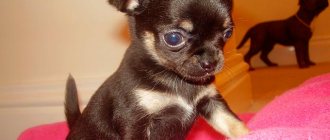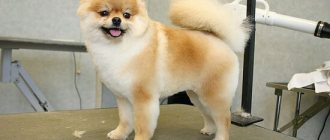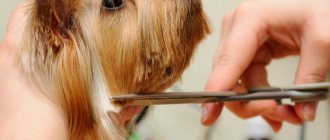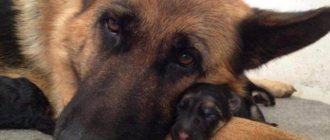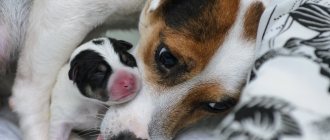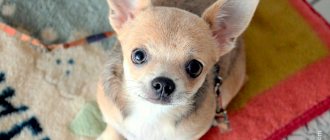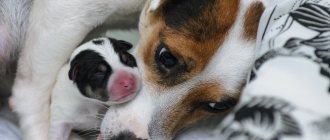Pregnancy and childbirth are a difficult period in the life of a Chihuahua. Unforeseen situations and complications arise at any stage. The reason may be the small size of the bitch, the disproportionately large head of the puppy, or pathologies of the animal. In order to provide your dog with the necessary help in a timely manner, you should carefully prepare for the birth of your Chihuahua, and if necessary, seek help from a veterinarian. A dog breeder should know how long pregnancy lasts, signs of impending birth, how it progresses and what care newborn puppies and Chihuahuas need.
How does pregnancy usually proceed in Chihuahuas?
Chihuahuas reach puberty with their first heat (at 6-8 months), but a responsible breeder will not breed a dog during this period. She is not ready for pregnancy and childbirth, either physically or psychologically. The first mating is recommended at the age of one and a half years, when the girl’s weight exceeds one and a half to two kilograms. Due to the small size of sneezes, childbirth at too young an age can end tragically for both the pet and her offspring. The maximum mating period is 10 years.
It is quite difficult to understand that a dog is pregnant in the first three weeks after fertilization. A blood test, ultrasound or x-ray can only confirm pregnancy in the third week. If the owner carefully observes the dog, he may notice a number of changes that occur 12-14 days after mating:
- An active Chihuahua becomes calm, and a phlegmatic one becomes fussy.
- She sleeps a lot.
- Appetite decreases.
- Vomiting is possible due to toxicosis.
- The mammary glands and nipples swell.
In the fifth week of pregnancy, the expectant mother’s activity decreases even more; she behaves calmly during walks, asks to go home and spends a lot of time on the bed. Gradually, the Chihuahua's belly increases in size. After the fourth week, toxicosis stops and appetite improves. After seven weeks, you may notice mucous discharge from the loop and colostrum in the breast. Immediately before giving birth (a day before), the Chihuahua's behavior is restless, she often licks herself, and her breathing becomes intermittent.
Estrus
Signs
It is usually quite easy to notice that a dog is in heat. First of all, the owner notices how his pet’s character changes: the dog may become too active or even aggressive.
Even the calmest Chihuahua can suddenly become overly playful or restless, and sudden mood swings may occur. The female Chihuahua begins to mark her territory to attract males, not only on the street, but also at home.
In addition to changes in behavior, there are also physiological factors by which estrus is accurately determined. The approach of this period can be seen by swollen nipples and labia, with characteristic discharge appearing on the latter.
When does the first heat start?
A dog's first heat begins between six months and a year, most often this event occurs at the age of 8 months.
Important! Dog owners may simply not notice the first heat - overlook its signs, not notice changes in mood, or attribute them to other factors. In order not to cause trouble for either themselves or the dog, from the age of six months they begin to carefully monitor the bitch, noticing all changes in mood.
How many days does it last?
The duration of estrus in Chihuahuas is not always the same; it can range from 18 to 25 days. However, first of all you need to count on the figure of 21 days, since this is the average for this breed.
The duration of estrus may depend on the dog's age, health and other factors.
How often does blood bleed a year?
Usually it takes 6-7 months from one heat to another. If you want to know exactly when to expect your next heat, you should mark the start and end dates of the period on a calendar.
On what day do Chihuahuas give birth?
The duration of Chihuahua pregnancy is 58-66 days. During this time, a number of biological processes occur in the female’s body.
The changes look like this:
- first week - fertilized eggs move into the horns of the uterus and are implanted into the mucous membrane;
- second - cell division occurs, the development of embryos that descend into the uterus;
- third – the Chihuahua’s nipples swell and the appetite changes;
- fourth - embryos can be palpated, the abdomen grows, the mammary glands swell more;
- fifth – the dog’s weight increases, the gender and number of puppies can be determined using ultrasound;
- sixth - the mammary glands darken, the volume of the bitch’s abdomen increases;
- seventh – a pregnant Chihuahua becomes nervous, hair falls out on its belly;
- eighth – childbirth is possible during multiple pregnancy;
- ninth - the dog behaves restlessly, does not leave the owner, produces colostrum, and begins to give birth.
It is worth considering that, depending on individual characteristics, pregnancy and childbirth of inexperienced Chihuahuas and those giving birth not for the first time proceed differently, so the changes that occur in the dog may have some deviations in timing.
Recording contractions
The body prepares for childbirth by contracting the muscles of the uterus, that is, contractions. As a result, the cervix gradually opens. This process is painful, so it can be determined by behavior. The dog becomes restless, breathes heavily and frequently, and rummages in the nest.
It is also very important to take into account physiological signs - the gradual lowering of the tummy. If your Chihuahua is pregnant and giving birth for the first time, then not everything is so obvious. The drooping of the abdomen may be barely noticeable, so be extremely careful. During contractions, you can see how the dog’s sides tense up and the characteristic pits on them. This usually lasts from an hour to a day.
As soon as you notice your dog's contractions, start recording the time. Afterwards, barely noticeable attempts begin. They gradually intensify, and the interval between them is about forty minutes. The process can take up to five hours after the first attempts. If after this period puppies do not begin to appear, then immediately contact your veterinarian. Your pet may not be able to cope with natural birth. In this case, the specialist will be forced to perform a caesarean section. Of course, you shouldn’t carry out such an operation yourself at home.
How long can labor last for a Chihuahua?
58-66 days after mating, birth occurs, which can be divided into three stages. The duration of the first (normal) is 6-12 hours. If a Chihuahua is in labor for the first time, she is very nervous, and the period lasts up to 36 hours. At this time, the female’s vagina relaxes, the cervix opens, and its walls begin to contract. The dog behaves restlessly - it breathes quickly, scratches the bedding, and looks anxiously at its belly.
With the onset of the second stage, the Chihuahua’s body temperature rises to 37.5-39 ⁰C, tension in the abdominal muscles becomes visible, attempts to hold the breath appear, and amniotic fluid drains. At first, the intervals between contractions in Chihuahua dogs last 20-30 minutes. Later, the intensity of labor increases, and pauses are reduced to 2-5 minutes. 20 minutes after the start of contractions, water appears, then the amniotic sac appears.
In the third stage, the placenta is expelled 15 minutes after the puppies are born. Several more babies may be born before her. It is important to monitor the bitch and not allow her to eat more than two placentas to avoid vomiting and gastrointestinal upset.
Childbirth lasts from two hours to two days. If contractions and attempts do not end with the birth of puppies within 2-3 hours, immediately call a veterinarian.
The appearance of puppies
Each kitten is located in the fetal membrane. It bursts when it passes through the birth canal. If this does not happen, the mother herself chews the protective film and frees the puppy. Then the Chihuahua bites the umbilical cord with its teeth and licks the emerging baby, thus giving it a massage. These activities help stimulate breathing and circulation.
After the birth of the first puppy, the placenta (placenta, fetal membranes and umbilical cord) also comes out. Chihuahuas usually eat them because they contain a lot of nutrients. They are necessary to gain additional strength and continue childbirth. Also, trace elements of the placenta have a good effect on milk production.
The birth of the next puppy does not occur immediately, but after a short period. The time interval can vary from one to sixty minutes. It can be considered that the Chihuahua's labor has ended if more than two hours have passed.
Decorative dogs are capable of bearing a small amount of fruit, and the owner should be aware of this. The number of pregnancies and the weight of the Chihuahua before birth is of great importance. By the way, normally this figure should be at least two kilograms. Depending on this, your pet can bring you from one to six puppies.
Childbirth of a Chihuahua: what you need to know
Every Chihuahua owner rightfully worries, worries and thinks about how the birth of their beloved dog will go. To avoid any problems, you need to carefully prepare for the arrival of newborns.
Preparing the place for childbirth
If the Chihuahua is healthy and there is no need to take it to the clinic for delivery, newborns are delivered at home.
A place is prepared in advance where the dog can safely give birth to babies. Choose an isolated room where there is no noise that distracts her from the process. The window into the room is covered with curtains so that direct sunlight does not enter the room.
A comfortable box for childbirth is installed in advance. You can make it yourself or buy it ready-made at a pet store. One of its walls is made removable so that the owner has access for cleaning and helping the family. The material for making the box is selected in such a way that it can be easily washed, since during childbirth the Chihuahua rests against the walls of the box with its paws.
The box is installed away from heating devices and drafts. The path to him is cleared so that he can quickly come to the rescue.
Two weeks before the expected date of birth, the Chihuahua is brought and placed in a room so that she gets used to the new place and at a crucial moment does not look for another secluded corner for herself. A day before, you need to lay an oilcloth on the bottom of the box, and a disposable diaper on it.
The temperature in the room must be maintained at about +28 ⁰C, since Chihuahuas do not tolerate both cold and heat. After two weeks, the mother and puppies are transferred from the box to a spacious bed or to a special house, and the air temperature is reduced to +22 ⁰C.
Preparation of equipment
In order for a Chihuahua to safely give birth to healthy babies, you need to prepare the following tools and supplies:
- rectal thermometer;
- plastic bottles for warm water or a heating pad;
- absorbent diapers;
- potassium permanganate, furatsilin solution or hydrogen peroxide;
- sterile scissors with rounded ends;
- cotton towels;
- medical alcohol;
- cotton pads or tampons;
- brilliant green;
- tweezers or surgical forceps;
- pipettes;
- silk threads for tying the umbilical cord;
- box for newborn chihuahuas;
- electronic balance;
- notepad and pen;
- phone number of a veterinarian or clinic in case of emergency.
The owner may need an anesthetic and hemostatic agent (Travmatin), drugs to stimulate labor and cardiac activity (Oxytocin and Cardiomin), saline solution, glucose injections and syringes. Before using drugs, you should consult a veterinarian.
All items and tools necessary for childbirth are placed in a box and stored not far from the sneeze box, so that at the crucial moment you do not have to search for the necessary equipment throughout the house.
Preparing for childbirth
Starting from the fifty-seventh day of pregnancy, you need to measure your Chihuahua's temperature twice a day. A bowl of clean water is placed next to the box, which is periodically replaced with fresh water. Salt, meat and fish are excluded from the diet. As soon as thick white or gray discharge appears in the loop, the dog’s body temperature begins to be measured more often - immediately before birth it drops to 36 ⁰C. If you gently stroke your pet with your palm, you will notice that before labor begins, the puppies in the mother’s belly stop moving. At this time, the Chihuahua girl’s genitals should be washed with warm water and soap. The vagina is treated with a solution of potassium permanganate, diluting it with water in a ratio of 1:1000. If furatsilin is used for disinfection, it is diluted in a ratio of 1:5000.
The owner himself must also prepare - trim his nails, disinfect his hands with alcohol. Before giving birth, Chihuahuas wear clean and comfortable clothes - they should not interfere with work, dangle, or cling to any objects.
The first signs of labor in a Chihuahua
Every Chihuahua owner should remember that labor normally begins 58-66 days after mating. If labor has not begun after 65-66 days, you should immediately consult a veterinarian. The specific day and hour of the Chihuahua's birth is determined by precursors. Although physiological signs are individual for each dog, a general picture of the imminent birth of puppies can be drawn. Its elements include:
- Relaxation of the muscles and ligaments of the pelvis one to two days before birth.
- Lowering of the abdomen.
- The appearance of colostrum in the nipples.
- 18-24 hours before birth, body temperature drops to 37-37.5 ⁰C.
- Within 5-10 hours, sneezers refuse to eat.
- The dog becomes restless, rushes about, moans, trembles, and its breathing quickens.
If, looking at the behavior of a pregnant Chihuahua, it seems that her stomach is bothering her, you need to be alert. Keep an eye on her, otherwise the pet may climb into a secluded place in a hard-to-reach corner of the apartment. In the last 24 hours before giving birth, you should constantly be with the dog, since contractions can frighten it, especially if the Chihuahua gives birth for the first time. The most reliable harbinger is the loss of amniotic fluid.
How does a Chihuahua's water break?
When contractions become as intense as possible, the cervix dilates completely. Pushing is a contraction of muscles, as a result of which the fetus moves along the birth canal. At this time, the Chihuahua should lie on its side and rest its paws against the wall of the box or box. This position makes it easier for the dog to endure the whole process. Childbirth begins with the loss of amniotic fluid. The amount of liquid can vary - from 15 to 50 ml. Color intensity ranges from transparent to brown or almost black. There is no need to worry if the amniotic fluid does not have an unpleasant putrefactive odor, and the Chihuahua’s body temperature is not higher than +39 ⁰C.
The water bladder ruptures on its own or the dog does it. The leaked liquid washes the birth canal and facilitates the birth of babies. No more than 3 hours pass before the Chihuahua gives birth to her first baby. If the time is up and there are still no puppies, you need to urgently seek help from a veterinarian.
If the birth proceeds normally, the dog will soon give birth to her first baby. It is located in the fetal membrane. Passing through the birth canal, it bursts on its own or is chewed by the bitch and releases the baby. The mother then bites the umbilical cord and licks the puppy, massaging the surface of the body, stimulating blood circulation and breathing.
How to deliver a Chihuahua?
After the mother licks the newborn and gnaws the umbilical cord, he switches to pulmonary breathing, the beginning of which is judged by the squeak made by the puppy. The owner writes down the time when he is born in a notebook, wipes the baby's body dry, weighs him and places him on the mother's chest. As soon as it is full, it is transferred to a prepared box with a heating pad and a soft diaper.
Following the fetus, the placenta emerges from the birth canal, detached from the uterus. The breeder must ensure that the number of puppies matches the number of afterbirths. There is no need to prevent your Chihuahua bitch from eating them. The body needs it to restore strength and normal lactation, but you should not allow you to eat more than two afterbirths.
Most often, a Chihua bitch gives birth to 1-3 puppies, but there are cases of multiple litters. The number of babies born must correspond to the indications of the ultrasound done during pregnancy.
Typically, home births for experienced sneezes do not require human intervention. A dog giving birth for the first time may need emergency care. If she behaves indifferently towards newborns, the following measures are taken:
- The puppy is freed from the amniotic sac when the bitch does not do this within two minutes after the baby is born.
- Clean his nose and mouth from mucus with a napkin.
- Gently wipe the chest and back against the grain to stimulate breathing.
- The umbilical cord is cut (at a distance of 2 cm from the abdomen) and disinfected.
- Treat the umbilical area with a solution of potassium permanganate.
Preparing the maternity area
The owner should have worried about preparing the “maternity hospital” 3 weeks before the Chihuahua started giving birth. If this has not been done, then build a maternity box from plywood, or use a spacious, thick cardboard box from household appliances. Subsequently, the box will become a temporary shelter for a dog with small puppies, so carefully consider its architecture.
Place the new “house” for the Chihuahua in a secluded and warm place, for example, close to the radiator. Place oilcloth and a large sheet on the bottom of the box. The dog will build a cozy “nest” from fabric for himself and his newborn babies.
To ensure that a pregnant Chihuahua can easily enter the box, make a proportionate entrance. Make the threshold (side) 10-15 cm high so that the cubs do not voluntarily leave their place of stay in the absence of the mother. For safety reasons, protect the “shelter” of mother and puppies from small children.
If you do not prepare a birthing area for a Chihuahua in advance, the dog will independently choose the place where it will give birth. Such a place may be any hard-to-reach corner of the apartment (house), which will prevent the owner from monitoring the normal course of labor and providing prompt assistance if necessary.
Make sure that the woman in labor spends most of her time in the place prepared for her, sleeping and resting. It is important that after giving birth the Chihuahua stays with the puppies in a designated place, and not anywhere.
Before giving birth to a Chihuahua at home, the owner should take care to ensure that the newborn puppies have an optimal and constant temperature in the apartment (private house). Optimal indoor air temperature for litter: +25-30 ° C. Remember that Chihuahuas are heat-loving dogs and hate sudden changes in temperature, especially cold. Even a small draft can result in the development of a cold in children.
Can a dog give birth on its own?
Only a small proportion of Chihuahua owners place their pets in a clinic for delivery. This is done for medical reasons. When everything is in order with the dog, it is able to give birth on its own without human intervention, but under his supervision.
Giving birth to a dog at home is quite common; it proceeds easily and without outside help if the Chihuahua meets several criteria:
- The woman in labor weighs at least 1.8-2 kg.
- Her age is from 1.5 to 4 years.
- There are no health contraindications.
If a Chihuahua does not meet at least one of the criteria, the likelihood of complications during childbirth and pathological abnormalities in the development of puppies increases.
To ensure everything goes smoothly, a pregnant Chihuahua needs to be seen at a veterinary clinic. The doctor will assess the condition and readiness of the dog to give birth on its own and give the necessary recommendations to the breeder. If a natural birth is not possible, a caesarean section is performed in the clinic.
When Chihuahuas give birth on their own, you need to create an environment of calm and safety at home. The bitch’s labor needs to be monitored from a short distance, and if necessary, be ready to react and help without fuss.
Stocking up on inventory
The tools required for proper childbirth in a Chihuahua are as follows:
- rectal thermometer;
- a heating pad or a couple of plastic bottles;
- hydrogen peroxide or potassium permanganate (potassium permanganate);
- dry and clean cotton towels;
- absorbent diapers;
- sterile sharp scissors;
- surgical forceps or tweezers;
- surgical silk threads or sterile catgut;
- cotton wool and medical alcohol;
- pipettes;
- electronic balance;
- notepad with pen;
- telephone number of the veterinarian or the nearest veterinary clinic in case of emergency.
The list can be supplemented with disposable syringes, Oxytocin or Mastometrin injection solution. The drugs are used to artificially stimulate labor in Chihuahuas. Consult your veterinarian regarding this issue.
Place the tools in a box and store them in a dry and easily accessible place.
What should you do after your Chihuahua gives birth?
After the Chihuahua has finished giving birth, she needs careful care and monitoring of her condition. First, wipe the bitch’s belly, nipples and genitals with a clean napkin soaked in a weak solution of potassium permanganate. Then they put things in order in the box - change the bedding, get rid of all traces of labor. In the first days after the birth of mini-Chihuahua puppies, the danger of hypothermia for babies is great, since their body’s independent thermoregulation is still not working well. The air temperature in the room and in the house is maintained at 28-30 ⁰C, and a safe heating pad is placed under the bedding. After three days it can be removed.
Immediately after the birth of the offspring, the Chihuahua should be allowed to rest for several hours, having first been given plain water or tea with milk. If the family lies calmly in the nest, the babies sleep and eat, and the mother licks them, turns them over, pushes them to the breast - then everything is in order.
During the postpartum period, you need to monitor the condition of the Chihuahua’s nipples - check for the presence of seals, if necessary, knead, compress, and place the babies directly on them.
In the first weeks, the puppies are not able to defecate on their own; their mother helps them by licking their belly. An inexperienced female sneeze needs to be helped by wiping the puppies' tummies along the growth of hair from the navel to the perineum after each feeding. The discharge from the bitch's loop is monitored for three weeks. If the color changes from red to black and an unpleasant odor appears, you need to seek help from a specialist.
Owner's help
In some cases, the dog cannot cope with the birth of puppies and the umbilical cord on its own. Especially if this is her first birth. You must be able to deliver and provide the necessary assistance.
Puppies, depending on the presentation, can be born either head first or tail first. The encased puppy does not need any additional help from you. If there are no special problems when the puppy is born head first, then in the case of a breech presentation, your help may be needed. Gently pull the baby by the legs, but in no case by the chest. Gradually, as it comes out, begin to pull the skin on the back, moving towards the back of the head, until you pull it out completely.
Release the newborn from the membrane as quickly as possible so that he can begin to breathe. If you notice that the puppy is not showing signs of life, clear his airways of mucus. To do this, use sterile gauze wipes to carefully clean the baby’s nose and mouth. Then lightly massage his body to stimulate vital activity.
To properly cut the umbilical cord, lift it over the puppy so that all the liquid flows back into him. Then step back two centimeters from the tummy, pinch it with your fingers and carefully cut off the remaining part with sterile scissors. If blood flows, tie the umbilical cord with sterile silk thread.
Problems that arise after childbirth
Even if the dog’s birth ended successfully, the first few weeks keep the bitch’s health under control. Body temperature is measured daily. It should gradually stabilize to 38-39 ⁰C, which is considered normal. On the first day (if there is a lot of milk) it can reach 39.5 ⁰С, but in the future a temperature above 40 ⁰С should be a reason to consult a doctor.
Among the most dangerous postpartum complications of a Chihuahua are:
- Pyometra is an inflammation of the uterus, in which the dog becomes feverish, lethargic, indifferent to puppies, and foul-smelling discharge appears from the vagina. Milk production decreases, body temperature rises, and without treatment, sepsis and death occur.
- Eclampsia is milk fever in which the bitch experiences excitement, nervousness, and difficulty walking. In the future, instability and loss of orientation in space, muscle spasms and convulsions develop. Death is inevitable if treatment is delayed or delayed.
- Mastitis is an enlargement and inflammation of the mammary glands, accompanied by high temperature, hardening, redness, and soreness of the affected lobes of the breast. The slightest touch causes pain in the dog, and after some time bloody or purulent discharge appears from the nipples.
If a Chihuahua that has recently given birth has an elevated body temperature, a bad mood, loss of appetite, or an unwillingness to care for puppies and give them attention, you should immediately seek help from a veterinarian.
Special food
From the fourth week after mating, they begin to increase the daily ration by 2% every 7 days.
If the dog is accustomed to commercial food, then when the gestation period reaches one month, it is transferred to specialized varieties aimed at females bearing offspring. They completely provide the body with the necessary elements.
With a natural menu, increase the amount of kefir, cottage cheese, fruits and vegetables, since the development of fruits requires more calcium, proteins, and various vitamins.
Carrots and buckwheat porridge are also useful for the female. Egg yolk is given weekly. They practice four meals a day. At the same time, make sure that the dog does not overeat.
Expert opinion
Anna Abramenko
An avid dog lover. Experience in veterinary medicine since 2009.
Ask a Question
Approximately 14 days before giving birth, the percentage of foods with a high concentration of calcium and protein in the diet is reduced.
7 days before the expected birth, rice or buckwheat porridge is boiled in water. Add a little butter. They give a mixture of crushed walnuts with grated raisins and dried apricots, and apple pieces. Recommended vegetables include zucchini, pumpkin, and boiled cauliflower. They make balls of rolled oats with cottage cheese.
When drawing up a weekly menu at all stages of pregnancy, you should consult with an experienced veterinarian. He will recommend vitamin and mineral supplements.
Feeding and care during the postpartum period
Pregnancy and labor greatly deplete a bitch's body. In order for her to feel great and for the puppies to have enough breast milk, feeding must be nutritious and balanced. After a successful birth, the Chihuahua mother is fed warm food - boiled eggs, chopped vegetables, cereals, offal and meat. You should not get carried away with feeding protein foods at first; excess meat and lack of calcium can cause eclampsia. This happens because calcium gluconate leaves the body of a lactating bitch along with milk, and protein oversaturation occurs due to improper feeding in the postpartum period. To prevent eclampsia, low-fat cottage cheese, kefir and other fermented milk products are introduced into the diet of a nursing female sneeze.
To enhance lactation in the first week after giving birth, the Chihuahua menu consists of tea with honey and milk, buckwheat porridge with the addition of butter, dried apricots, nuts and raisins. She needs cottage cheese with rolled oats, boiled pumpkin, zucchini and cauliflower.
In the second and third weeks after the puppies are born, the diet is supplemented with boiled fish, lean meat and calcined cottage cheese.
On the advice of a veterinarian, food is fortified using special supplements with a high content of calcium and vitamin D.
Mating
When should I do this for the first time?
In fact, a female dog reaches puberty after her first heat, but this does not mean that her body is ready to bear puppies. You can knit a pet no earlier than one and a half years old.
Matings are not necessary for any breed. If you decide to breed a dog, you must remember that dogs under 1.8 kg are included in the so-called “risk group”. However, Chihuahuas are very individual in their development. Before mating, consult a veterinarian - only he can tell for sure whether the dog is ready to bear offspring.
What day should I knit?
Estrus in dogs is divided into four main periods:
- proestrus;
- estrus;
- metestrus;
- anestrus.
The first lasts about 6-9 days, the second usually does not exceed five days, the third continues for the remaining time until the end of the heat. Anestrus is a period of rest between estrus.
It is the second period - estrus - that is the only optimal one for breeding a dog. At this time, the bitch experiences a strong attraction to male dogs, she is actively looking for a partner and has almost no control over her actions. Therefore, you should be extremely careful and attentive to avoid the appearance of mixed-breed puppies.
Males for mating
Choosing a male dog can be difficult. Not every dog can become an ideal father of offspring. Every dog has its flaws.
You need to find a male whose advantages outweigh his disadvantages. It is worth paying attention not only to external compliance with standards, but also to the dog’s behavior, its character, and adequacy.
A special strategy would be to choose a partner for your dog whose disadvantages will be compensated by the advantages of the bitch, and vice versa. This approach will bring the best results, but the search for a male dog may take a long time.
How to do it correctly?
First of all, you should make the mating process as comfortable as possible for the dogs.
Mating should take place in the house where the dog lives, and not his partner. The female is let into the room first so she can look around, then the male is allowed in. In a new place, the dog may get scared and try to attack its partner. To prevent this from happening, you should put a muzzle on the dog.
The floor in the room should not be slippery. If the dogs are inexperienced, it is best to rely on a trainer to help both parties understand the process.
When do you need a veterinarian?
An attentive and experienced dog breeder will always be able to notice emerging problems that require the help of a specialist.
The following facts should alert you:
- bloody or black discharge appeared before childbirth;
- after five hours of intense pushing, the puppies had not yet appeared;
- the kitten is stuck in the birth canal;
- the interval between the birth of babies exceeds two hours;
- The dog lost consciousness from severe pain.
You should arrange a possible call with the veterinarian in advance.


